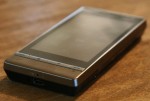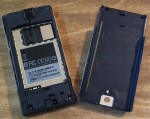One of the more exciting announcements to come from Mobile World Congress was that HTC would be releasing the Touch Diamond2 and TouchPro2 as followups to their preceding namesakes. Neither is technically available in the US – not just yet anyway, but as luck would have it, HTC was kind enough to loan me a European version of the Diamond2.
When I say European version, I basically mean that the data part of the phone is set up for Asian / European networks and doesn’t utilize US 3G speeds, but it will still work just fine on any US EDGE or GSM cellular system.
Let’s take a look…
I’m not sure if mine is a final retail version, or if basic black is the HTC equivalent to Palm’s plain white review sample box, but the packing was definitely no frills and not what I have come to expect from HTC’s flagship models. I basically found a bit of egg crate cradling the goodies inside and a partition for the items that didn’t fit in the main compartment.
Inside the box are the Diamond2, a USB sync & charge cable, an AC adapter, an extra stylus, and a headset.
Specifications:
Processor: Qualcomm® MSM7200A™, 528 MHz
OS: Windows Mobile® 6.1 Professional (it should be upgradeable to 6.5)
Memory: 512 MB ROM, 288 MB RAM
Memory Expansion: microSD™ memory card (SD 2.0 compatible)
Dimensions: 4.25″ tall X 2.09″ wide X 0.54″ thick
Weight: 4.15 ounces (with battery)
Display: 3.2 inch TFT-LCD WVGA (480×800) touchscreen
Camera: 5 megapixel autofocus camera
Battery: 1100mAh LiIon
Network: HSDPA/WCDMA: Europe/Asia: 900/2100 MHz; Quad-band GSM/GPRS/EDGE: Europe/Asia: 850/900/1800/1900 MHz
Connectivity: Bluetooth 2.0 with EDR and A2DP for wireless stereo headsets; Wi-Fi: IEEE 802.11 b/g
Expansion Slot: microSD (SD 2.0 compatible)
Special Features: FM Radio, G-Sensor
The HTC Touch Diamond2 measures 4.25″ tall X 2.09″ wide X 0.54″ thick, and it weighs 4.15 ounces with its battery installed. This makes it a little bit larger and a little bit heavier than its predecessors – European and American versions, which Mitchell and I each reviewed.
The front half of the PDA phone’s body is rimmed in a matte silver metal, which looks a little bit retro (in a good way!) and is possibly responsible for the device’s extra rigidity – it absolutely will not flex or creak when torqued.
The front of the Diamond2 is beautiful; not only is the borderless 3.2″ WVGA (480×800) touchscreen surrounded by a flush black plastic border which makes it seem even larger, HTC has gone with subtle matte silver buttons which seem to nearly blend in with the device’s matte metal bottom. From left to right, the buttons are Call, Start, Back, and End (Home). At the upper end there is an earpiece with an LED indicator light on its left and a video call camera on the upper right for countries with carriers who support that feature.
One of the neatest features is not immediately evident: right above the buttons and built into the black portion of the screen, you might be able to just make out the magnifying glass with a + or -; that’s the Zoom Bar. Swiping your finger will allow you to zoom in and out on “photos, documents, maps, web pages, and more.” It will also allow you to change font sizes from within certain programs, such as Ilium Software‘s RSS Hub. Very cool!
On the top left of the Diamond2, there is a combination Power and screen backlight toggle button.
On the upper left side is a elongated volume rocker.
The bottom of the device has a combination sync/charge/headset port and the microphone. On the bottom right is the stylus silo. I have yet to remove and actually use the stylus; having one almost seems to be a throwback to the old days, and the device is certainly tuned to allow as much finger action as possible. The stylus isn’t magnetic, which the original Diamond’s was, but when it is pulled out it will wake the device and turn on the screen’s backlight.
The only item on the right side is the speaker, which basically looks like it ought to be a miniSD memory card slot.
Flipping the Diamond2 over reveals one of the only things about the device’s appearance that has disappointed me thus far: it has a shiny, fingerprint and smudge magnetic, black backside.
Every time I look at it and every time I pick the phone up, I wish that the back was either composed of the same matte metal as the front or that the back was covered with the same rubberized facet design as the HTC Rose (S740). And then I have to compulsively wipe it, just because.
Ah well…there always has to be something that bugs me, right?
Also present on the back is the lens for the 5 megapixel camera. There’s no LED flash, but the camera has a very capable autofocus.
The weird thing is that for the most part, the pictures look pretty good – sharp and very well focused. But they are also badly washed out. I am not sure why since I had everything on AUTO to avoid any possible user error. Looking at my photos, it’s almost as if there is a haze covering the camera’s lens…or something. But that may just be a problem with “my” Diamond2.
See what I mean?
Sliding off the battery cover, we find the internal antenna on the bottom, the 1100mAh battery, the SIM slot, and on the left a microSD slot.
Tapping the Call End (Home) button pulls up the now familiar HTC Home screen; similar to the HTC Touch HD, haptic feedback is given when touching the icons on the bottom of the Home screen, but there is also feedback given when typing with the onscreen keyboard. Holy cow, does this make a difference in my tapping accuracy!
Tapping the Start button (the soft one on the screen or the hard one on the bottom button row) brings up a very finger friendly HTC launcher – there is no haptic feedback when touching these icons, which seems like a missed opportunity.
So far I am impressed with the Diamond2. It’s extremely snappy, finger friendly, and the screen is gorgeous. I’ll have more to say after I’ve used it for a few more weeks… 🙂





























Certainly looks good, but I’m a tad confused where this slips in with the Touch HD. Specs look extremely similar.
I agree it would be awesome if the back was brushed metal 😛
i just got mine yesterday, and i don’t have any haziness on the photos, though i haven’t viewed them on my pc. As a year old iphone user (both 2g and 3g), im quiet impress in the snappiness of this device as a winmo. the screen is definitely very crisp due to the wvga resolution. still getting used to the resistive screen but the adjustment is not that big, unlike the previous model, dont need a lot of pressure on the screen translates a fast response almost instantaneous. Sunlight legibility is average, but useable as i was taking photos on broad daylight and reading messages outside.
now, im waiting for the winmo6.5 to beef it up. Oh yah, forgot to mention that i havent used the stylus.
overall, its a very capable business phone